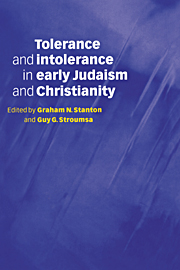Book contents
- Frontmatter
- Contents
- List of contributors
- List of abbreviations
- Introduction
- 1 Intolerance and martyrdom: from Socrates to Rabbi ‘Aqiva
- 2 The other in 1 and 2 Maccabees
- 3 The pursuit of the millennium in early Judaism
- 4 Conservative revolution? The intolerant innovations of Qumran
- 5 Who was considered an apostate in the Jewish Diaspora?
- 6 Why did Paul persecute the church?
- 7 Paul and the limits of tolerance
- 8 Philo's views on paganism
- 9 Coexisting with the enemy: Jews and pagans in the Mishnah
- 10 Tertullian on idolatry and the limits of tolerance
- 11 The threefold Christian anti-Judaism
- 12 The intertextual polemic of the Markan vineyard parable
- 13 Jews and Jewish Christians in the land of Israel at the time of the Bar Kochba war, with special reference to the Apocalypse of Peter
- 14 The Nazoreans: living at the boundary of Judaism and Christianity
- 15 Justin Martyr's Dialogue with Trypho: group boundaries, ‘proselytes’ and ‘God-fearers’
- 16 Accusations of Jewish persecution in early Christian sources, with particular reference to Justin Martyr and the Martyrdom of Polycarp
- 17 Early Christians on synagogue prayer and imprecation
- 18 Messianism, Torah and early Christian tradition
- 19 Jewish and Christian public ethics in the early Roman Empire
- Postscript: the future of intolerance
- General bibliography
- Index
Introduction
Published online by Cambridge University Press: 08 March 2010
- Frontmatter
- Contents
- List of contributors
- List of abbreviations
- Introduction
- 1 Intolerance and martyrdom: from Socrates to Rabbi ‘Aqiva
- 2 The other in 1 and 2 Maccabees
- 3 The pursuit of the millennium in early Judaism
- 4 Conservative revolution? The intolerant innovations of Qumran
- 5 Who was considered an apostate in the Jewish Diaspora?
- 6 Why did Paul persecute the church?
- 7 Paul and the limits of tolerance
- 8 Philo's views on paganism
- 9 Coexisting with the enemy: Jews and pagans in the Mishnah
- 10 Tertullian on idolatry and the limits of tolerance
- 11 The threefold Christian anti-Judaism
- 12 The intertextual polemic of the Markan vineyard parable
- 13 Jews and Jewish Christians in the land of Israel at the time of the Bar Kochba war, with special reference to the Apocalypse of Peter
- 14 The Nazoreans: living at the boundary of Judaism and Christianity
- 15 Justin Martyr's Dialogue with Trypho: group boundaries, ‘proselytes’ and ‘God-fearers’
- 16 Accusations of Jewish persecution in early Christian sources, with particular reference to Justin Martyr and the Martyrdom of Polycarp
- 17 Early Christians on synagogue prayer and imprecation
- 18 Messianism, Torah and early Christian tradition
- 19 Jewish and Christian public ethics in the early Roman Empire
- Postscript: the future of intolerance
- General bibliography
- Index
Summary
The essays in this book consider issues of tolerance and intolerance faced by Jews and Christians between approximately 200 BGE and 200 GE. Where were boundaries drawn and bridges built? Although this theme is explored primarily from a historical perspective, for both Jews and Christians it resonates down through the centuries right up to the present day. Communities, groups or nations with rigid boundaries of intolerance quickly become sterile: where there is no vision, people perish. So bridges must be built. On the other hand, unless clear boundary lines are drawn, bridges of tolerance which straddle political, ethnic or religious boundaries are always vulnerable both to sudden attack and to steady erosion. The location of boundaries and bridges raised particularly acute problems for both Jews and Christians in the period under discussion in this book, but the issues at stake will always be with us. The contributors hope to stimulate further research on their chosen topics, as well as reflection on the wider implications of their essays.
This book is distinctive both in its concentration on a theme of perennial concern for humanity, and also in the breadth of the essays. As might be expected in a volume on tolerance and intolerance in antiquity, several chapters are concerned with many different aspects of early Jewish–Christian relationships. Five scholars, however, take a different tack and explore wider horizons: they discuss ways Jews and Christians defined themselves over against the pagan world. As minority groups, both Jews and Christians had to work out ways of coexisting with their Graeco-Roman neighbours.
- Type
- Chapter
- Information
- Publisher: Cambridge University PressPrint publication year: 1998



